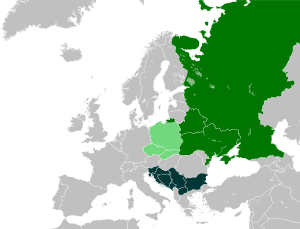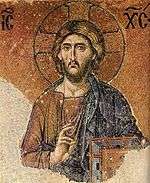Russians
Russians (Russian: русские, tr. russkiye, IPA: ˈruskʲɪje) are an East Slavic ethnic group native to Eastern Europe.[42][43] They are the most numerous ethnic group in Europe. The majority of ethnic Russians live throughout the Russian Federation, but notable minorities exist in other former Soviet states such as Belarus, Kazakhstan, Moldova, Ukraine and the Baltic states. A large Russian diaspora (sometimes including Russian-speaking non-Russians) has developed all over the world, with notable numbers in the United States, Germany, Brazil, and Canada. The culture of the ethnic Russian people has a long tradition and it is a foundation for the modern culture of the whole of Russia. The Russian language originally was the language of ethnic Russians. They are historically Orthodox Christians by religion. Most of ethnic Russians share a common history, culture, language and religion or related background.
| Total population | |
|---|---|
| 129 million[1] | |
| Regions with significant populations | |
| Diaspora | |
| 7,170,000 (2018) including Crimea[3] | |
| 3,644,529 (2016)[4] | |
| 3,500,000 (including Russian Jews and Russian Germans) 1,213,000 (excluding ethnic German repatriates)[5][6] | |
| 3,072,756 (2009) (including Russian Jews and Russian Germans)[7] | |
| 938,500 (2011) (including Russian Jews)[8] | |
| 785,084 (2009)[9] | |
| 750,000 (2016)[10] | |
| 622,445 (2016) (Russian ancestry, excluding Russian Germans)[11] | |
| 487,250 (2018)[12] | |
| 201,218 (2014)[13] | |
| 352,960 (2018)[14] | |
| 340,000[15] | |
| 327,802 (2020)[16] | |
| 300,000 (2018)[17] | |
| 150,000 (2012)[18] | |
| 129,797 (2017)[19] | |
| 120,459[20] | |
| 119,300 (2009)[21] | |
| 96,000[22] | |
| 85,534 (2018) (immigrants) 78,500 (descendants)[23] | |
| 67,055 (2006)[24] | |
| 50,000 (Russian ancestry)[25] | |
| 36,397 (2002) (Lipovans)[26] | |
| 35,759 (2016)[27] | |
| 35,000 (2010)[28] | |
| 30,098 (2016)[29][30] | |
| 26,453 (2014)[31] | |
| 21,518 (2016)[32] | |
| 20,187 (2016)[33] | |
| 15,609 (2000)[34] | |
| 15,595 (2002)[35] | |
| 14,660 (2002)[36] | |
| 13,635 (2002)[37] | |
| 12,200 (2019) | |
| 7,686 (2019)[38] | |
| 5,979 (2013)[39] | |
| 4,952 (2001)[40] | |
| Languages | |
| Russian | |
| Religion | |
| Predominantly (Russian Orthodox Church) | |
| Related ethnic groups | |
| Other East Slavs (Belarusians and Ukrainians),[41] Eastern South Slavs (Bulgarians, Serbs, Macedonians, and Montenegrins) | |
The ethnic Russians formed from East Slavic tribes and their cultural ancestry is based in Kievan Rus'. The Russian word for ethnic Russians is derived from the people of Rus' and the territory of Rus'. The Russians share many historical and cultural traits with other European peoples, and especially with other East Slavic ethnic groups, specifically Belarusians and Ukrainians. Officials until 1917 used the word Russian for all peoples originated in Rus', i.e. all of East Slavs. Those "Russians" (East Slavs in modern terminology) who lived outside of central Kievan Rus' (Ruthenia minor) in Ruthenia magna were specified as Velikorossy (roughly translated as Great Russians) with spoken Great Russian language. After 1917 Great Russians was renamed Russians and modern terminology is used since then. In the former Russian Empire and Soviet Union many ethnic groups had a common history and these countries were influential in the spreading of Russian culture and language. The Russian language is official in Russia, Belarus, Kazakhstan, Kyrgyzstan, and Tajikistan, and is also spoken as a secondary language in many former Soviet states.
The ethnic Russians make up the largest of the 194 ethnic groups who live in Russia, according to the 2010 census. Some 80.90% (111,016,896 people) of the population identified voluntarily as ethnically Russian. The Constitution declares Russia to be a multiethnic state and it named the "multiethnic people of Russia"[44] as a sovereign nation (i.e. not ethnic Russian, officially Russia is not a nation state). The Russian word used for citizens of Russia is different from the word for ethnic Russian (see Citizenship of Russia); other languages often do not distinguish between these two groups. The Tsardom of Russia became a multi-ethnic state in the 16th century in its imperial phase (see History of Russia). The number of ethnic Russians living outside the Russian Federation is estimated at roughly between 20 and 30 million people (see Russian diaspora).
Ethnonym
Two Russian words are commonly translated into English as "Russians". One is "русские" (russkiye), which most often means "ethnic Russians" (the subject of this article). Another is "россияне" (rossiyane), which means "citizens of Russia". The former word refers to ethnic Russians, regardless of what country they live in or whether they hold Russian citizenship. Under certain circumstances, this term may or may not extend to denote members of other Russian-speaking ethnic groups from Russia, or from the former Soviet Union. The latter word refers to all people holding citizenship of Russia, regardless of their ethnicity, and does not include ethnic Russians living outside Russia. Translations into other languages often do not distinguish these two groups.[45]
The name of the Russians derives from the Rus' people (supposedly Varangians). According to the most prevalent theory, the name Rus', like the Finnish name for Sweden (Ruotsi), is derived from an Old Norse term for "the men who row" (rods-) as rowing was the main method of navigating the rivers of Eastern Europe. It could be associated to the Swedish coastal area of Roslagen (Rus-law) or Roden, as it was known in earlier times.[46][47] The name Rus' would have the same origin as the Finnish and Estonian names for Sweden: Ruotsi and Rootsi.[48] Although Russian history and culture is shaped also by Germanic people such as the Vikings, there are also theories that Rus' is of a non-Germanic origin. According to the historian Lydia Groth, Roslagen in IX—XII centuries was unsuitable for life, as it was under water at a depth of 6–7 meters. Furthermore, the name Roslagen was first documented only in 1493.[49][50] According to other theories the name Rus' is derived from Proto-Slavic *roud-s-ь ( from *rъd-/*roud-/*rуd- root), connected with red color (of hair)[51] or from Indo-Iranian (ruxs/roxs — «light-colored», «bright»).[52]
Until the 1917 revolution, Russian authorities never specifically called the people "Russians", referring to them instead as "Great Russians," a part of "Russians" (all the East Slavs).
History
Origin
The modern Russians formed from two groups of East Slavic tribes: Northern and Southern. These tribes included the Krivichs, Ilmen Slavs, Radimichs, Vyatiches and Severians. Genetic studies show that modern Russians do not differ significantly from Belarusians and Ukrainians. Some ethnographers, like Dmitry Konstantinovich Zelenin, affirm that Russians are more similar to Belarusians and to Ukrainians than southern Russians are to northern Russians. Russians in northern European Russia share moderate genetic similarities with Finnic peoples,[41][53] who lived in modern north-central European Russia and were partly assimilated by the Slavs as the Slavs migrated northeastwards. Such Finnic peoples included the Merya[54] and the Muromians.[53][55]
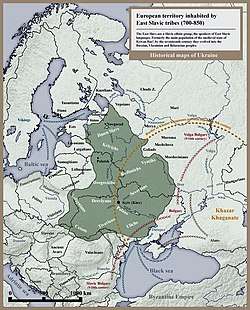
The territory of Russia has been inhabited since 2nd Millennium BCE by Indo-European, Ural-Altaic, and various other peoples; however, not much is known about them.[56] Slavic people are native to the western part of Russia.[57] Outside archaeological remains, little is known about the predecessors to Russians in general prior to 859 AD, when the Primary Chronicle starts its records.[58] By 600 AD, the Slavs are believed to have split linguistically into southern, western, and eastern branches.
The eastern branch settled between the Southern Bug and the Dnieper rivers in present-day Ukraine; from the 1st century AD through almost the turn of the millennium, they spread peacefully northward to the Baltic region, forming the Dregovich, Radimich and Vyatich Slavic tribes on the Baltic substratum. They developed some changed language features, such as vowel reduction. Later, both Belarusians and South Russians emerged from this ethnic linguistic ground or family.[59]
From the 6th century onward, another group of Slavs moved from Pomerania to the northeast of the Baltic Sea, where they encountered the Varangians of the Rus' Khaganate and established the important regional center of Novgorod. The same Slavic ethnic population also settled the present-day Tver Oblast and the region of Beloozero. With the Uralic substratum, they formed the tribes of the Krivichs and of the Ilmen Slavs.
Kievan Rus'
Kievan Rus' was a loose federation of states that existed from the late 9th to the mid-13th century. Modern Russians derive their name and cultural ancestry from Kievan Rus'.
Russian Empire
The Russian Empire was formed by Russians in modern-day Russia. It was given its name in 1721 and followed Russia’s victory over the Swedish Empire in what is known as the Great Northern War, in which Russia gained control of the Baltic.
 Principalities of Kievan Rus', 1220–1240. These principalities included Vladimir-Suzdal, Smolensk, Chernigov or Ryazan, annexed by the Duchy of Moscow in 1521
Principalities of Kievan Rus', 1220–1240. These principalities included Vladimir-Suzdal, Smolensk, Chernigov or Ryazan, annexed by the Duchy of Moscow in 1521 Russia's Arctic coastline from the White Sea to the Bering Strait had been explored and settled by Pomors, Russian settlers from Novgorod
Russia's Arctic coastline from the White Sea to the Bering Strait had been explored and settled by Pomors, Russian settlers from Novgorod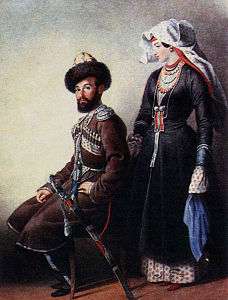 Terek Cossacks of the north Caucasus guarded the southern frontier
Terek Cossacks of the north Caucasus guarded the southern frontier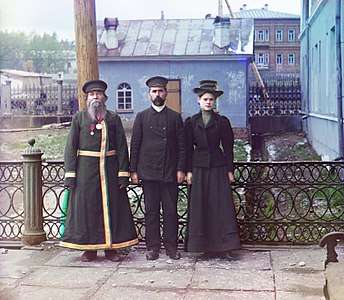 Three generations of a Russian family, the Kaganovs, from the Urals, ca. 1910. Photo taken by Sergey Prokudin-Gorsky
Three generations of a Russian family, the Kaganovs, from the Urals, ca. 1910. Photo taken by Sergey Prokudin-Gorsky
Population
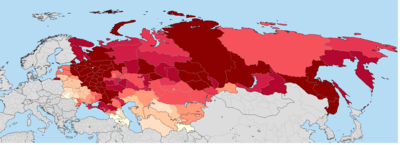
In 2010, the world's Russian population was 129 million people of which 86% were in Russia, 11.5% in the CIS and Baltic countries, with a further 2.5% living in other countries.[60]
Russia
Roughly 111 million ethnic Russians live in Russia, 80% of whom live in the European part of Russia, and 20% in the Asian part of the country.
.jpg)
Former Soviet states
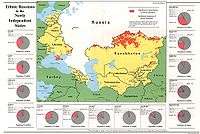
After the Dissolution of the Soviet Union an estimated 25 million Russians began living outside of the Russian Federation, most of them in the former Soviet Republics.
Diaspora
Ethnic Russians historically migrated throughout the area of former Russian Empire and Soviet Union, sometimes encouraged to re-settle in borderlands by the Tsarist and later Soviet government.[61] On some occasions, ethnic Russian communities, such as Lipovans who settled in the Danube delta or Doukhobors in Canada, emigrated as religious dissidents fleeing the central authority.
After the Russian Revolution and Russian Civil War starting in 1917, many Russians were forced to leave their homeland fleeing the Bolshevik regime, and millions became refugees. Many white émigrés were participants in the White movement, although the term is broadly applied to anyone who may have left the country due to the change in regime.
Today the largest ethnic Russian diasporas outside Russia live in former Soviet states such as Ukraine (about 8 million), Kazakhstan (about 3.8 million), Belarus (about 785,000), Latvia (about 520,000) with the most Russian settlement out of the Baltic States which includes Lithuania and Estonia, Uzbekistan (about 650,000) and Kyrgyzstan (about 419,000).
There are also small Russian communities in the Balkans, including Lipovans in the Danube delta,[62] Central European nations such as Germany and Poland, as well Russians settled in China, Japan, South Korea, Mexico, Brazil, Argentina and Australia. These communities may identify themselves either as Russians or citizens of these countries, or both, to varying degrees.
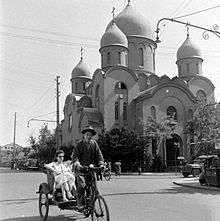
People who had arrived in Latvia and Estonia during the Soviet era, including their descendants born in these countries, mostly Russians, became stateless after the dissolution of the Soviet Union and were provided only with an option to acquire naturalised citizenship. The language issue is still contentious, particularly in Latvia, where ethnic Russians have protested against plans to liquidate education in minority languages, including Russian. Since 1992, Estonia has naturalized some 137,000 residents of undefined citizenship, mainly ethnic Russians. 136,000, or 10 percent of the total population, remain without citizenship. Both the European Union and the Council of Europe, as well as the Russian government, expressed their concern during the 1990s about minority rights in several countries, most notably Latvia and Estonia. In Moldova, the Transnistria region (where 30.4% of the population is Russian) broke away from government control amid fears the country would soon reunite with Romania. In June 2006, Russian President Vladimir Putin announced the plan to introduce a national policy aiming at encouraging ethnic Russians to immigrate to Russia.[63]
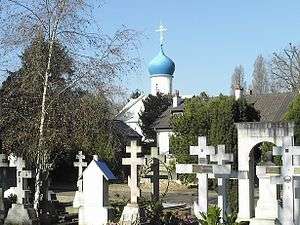
Significant numbers of Russians emigrated to Canada, Australia and the United States. Brighton Beach, Brooklyn and South Beach, Staten Island in New York City is an example of a large community of recent Russian and Russian Jewish immigrants. Other examples are Sunny Isles Beach, a northern suburb of Miami, and in West Hollywood of the Los Angeles area.
At the same time, many ethnic Russians from former Soviet territories have emigrated to Russia itself since the 1990s. Many of them became refugees from a number of states of Central Asia and Caucasus (as well as from the separatist Chechen Republic), forced to flee during political unrest and hostilities towards Russians.
After the Russian Revolution in 1917, many Russians who were identified with the White army moved to China — most of them settling in Harbin and Shanghai.[64] By the 1930s, Harbin had 100,000 Russians. Many of these Russians had to move back to the Soviet Union after World War II. Today, a large group of people in northern China can still speak Russian as a second language.
Russians (eluosizu) are one of the 56 ethnic groups officially recognized by the People's Republic of China (as the Russ); there are approximately 15,600 Russian Chinese living mostly in northern Xinjiang, and also in Inner Mongolia and Heilongjiang.
Culture
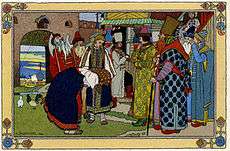
Russian culture originated from that of the East Slavs, who were largely polytheists, and had a specific way of life in the wooded areas of Eastern and Northern Europe. The Scandinavian Vikings, or Varangians, also took part in forming the Russian identity and state in the early Kievan Rus' period of the late 1st millennium AD. The Rus' accepted Christianity from the Byzantine Empire in 988, and this largely defined Russian culture for the next millennium, namely as a synthesis of Slavic and Byzantine cultures.[65] After the fall of Constantinople in 1453, Russia remained the largest Orthodox nation in the world and claimed succession to the Byzantine legacy in the form of the Third Rome idea.[66] At different points of its history, the country was strongly influenced by European culture, and since the reforms of Peter the Great Russian culture largely developed in the context of Western culture. For most of the 20th century, Marxist ideology shaped the culture of the Soviet Union, where Russia, i.e. the Russian SFSR, was the largest and leading part.
Russian culture is varied and unique in many respects. It has a rich history and a long tradition in all of the arts,[67] especially in fields of literature[68] and philosophy, classical music[69][70] and ballet,[71] architecture and painting, cinema[72] and animation, all of which had considerable influence on world culture.
Russian literature is known for such notable writers as Aleksandr Pushkin, Leo Tolstoy, Fyodor Dostoevsky, Anton Chekhov, Vladimir Mayakovsky, Boris Pasternak, Anna Akhmatova, Joseph Brodsky, Maxim Gorky, Vladimir Nabokov, Mikhail Sholokhov, Mikhail Bulgakov, Andrei Platonov, Aleksandr Solzhenitsyn, and Varlam Shalamov. Russians also gave the classical music world some very famous composers, including Piotr Ilyich Tchaikovsky and his contemporaries, the Mighty Handful, including Modest Mussorgsky and Nikolai Rimsky-Korsakov. In the 20th-century Russian music was credited with such influential composers as Dmitri Shostakovich, Sergei Prokofiev, Sergei Rachmaninoff, Igor Stravinski, Georgy Sviridov.
Language
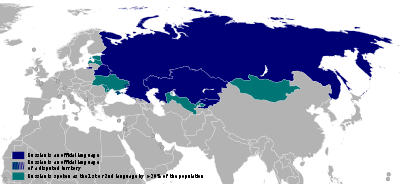
Russian (русский язык , transliteration: Russkiy yazyk, [ˈruskʲɪj jɪˈzɨk]) is the most geographically widespread language of Eurasia and the most widely spoken of the Slavic languages. Russian belongs to the family of Indo-European languages and is one of three (or, according to some authorities, four) living members of the East Slavic languages, the others being Belarusian, Ukrainian and Rusyn.
Examples of Old East Slavonic are attested from the 10th century onwards, and while Russian preserves much of East Slavonic grammar and a Common Slavonic word base, modern Russian exhibits a large stock of borrowed international vocabulary for politics, science, and technology.
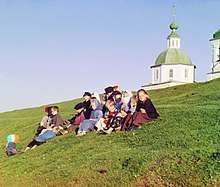
Russian has palatal secondary articulation of consonants, the so-called soft and hard sounds. This distinction is found in most consonant phonemes and is one of the most distinguishing features of the language. Another important aspect is the reduction of unstressed vowels, not unlike a similar process in English. Stress in Russian is often described as "unpredictable": it can fall on almost any syllable, and this is one of the difficult aspects for foreign language learners.
Due to the status of the Soviet Union as a super power, Russian gained a great political importance in the second half of the 20th century. It is one of the official languages of the United Nations. All astronauts working in the International Space Station are required to master Russian.
According to data published in the journal «Language Monthly» (No. 3, 1997), approximately 300 million people around the world at the time mastered the Russian language (making it the 5th most popular language in the world by total number of speakers), while 160 million considered Russian their native language (making it the 7th in the world by number of native speakers). The total number of Russian speakers in the world in the 1999 assessment was about 167 million, with about 110 million people speaking Russian as a second language.
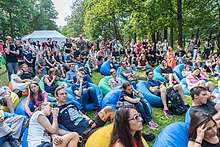
Prior to 1991, Russian was the language of international communication of the USSR and the most common foreign language taught in schools in the countries of the Eastern Bloc in Central Europe. It continues to be used in the countries that were formerly parts of the Soviet Union, both as the mother tongue of a significant percentage of the population, and as a language of international communication. While for various reasons residents of these countries might be unwilling to openly identify with Russian language, a major sociological study on the Russian language in the post-Soviet states conducted by Gallup, Inc., revealed that 92% of the survey respondents in Belarus, 83% in Ukraine, 68% in Kazakhstan and 38% in Kyrgyzstan chose Russian-language forms to complete the questionnaire for the survey (most notably, over forms in corresponding national languages).
In the U.S. state of New York in 2009, an amendment to the electoral law was adopted, according to which in all cities in the state having over a million people, all documents related to the election process should be translated into Russian (thus gaining equal status with Spanish, Korean, Filipino, Creole languages and three varieties of Chinese).
In places of compact residence of immigrants from the countries of the former USSR (Israel, Germany, Canada, the United States, Australia, etc.) Russian-language periodicals, radio and television channels are available, as well as Russian-language schools.
Religion
.jpg)
As of a different sociological surveys on religious adherence, from 41% to over 80% of the total population of Russia adhere to the Russian Orthodox Church.[73][74][75][76][77] It has played a vital role in the development of Russian national identity. In other countries Russian faithful usually belong to the local Orthodox congregations which either have a direct connection (like the Ukrainian Orthodox Church, autonomous from the Moscow Patriarchate) or historical origin (like the Orthodox Church in America or a Russian Orthodox Church Outside of Russia) with the Russian Orthodox Church.
Non-religious Russians may associate themselves with the Orthodox faith for cultural reasons. Some Russian people are Old Believers: a relatively small schismatic group of the Russian Orthodoxy that rejected the liturgical reforms introduced in the 17th century. Other schisms from Orthodoxy include Doukhobors which in the 18th century rejected secular government, the Russian Orthodox priests, icons, all church ritual, the Bible as the supreme source of divine revelation and the divinity of Jesus, and later emigrated into Canada. An even earlier sect were Molokans which formed in 1550 and rejected Czar's divine right to rule, icons, the Trinity as outlined by the Nicene Creed, Orthodox fasts, military service, and practices including water baptism.
Other world religions have negligible representation among ethnic Russians. The largest of these groups are Islam with over 100,000 followers from national minorities,[73] and Baptists with over 85,000 Russian adherents.[78] Others are mostly Pentecostals, Evangelicals, Seventh-day Adventists, Lutherans and Jehovah's Witnesses.
Since the fall of the Soviet Union various new religious movements have sprung up and gathered a following among ethnic Russians. The most prominent of these are Rodnovery, the revival of the Slavic native religion also common to other Slavic nations,[79] Another movement, very small in comparison to other new religions, is Vissarionism, a syncretic group with an Orthodox Christian background.
Notable achievements

Russians have greatly contributed to the fields of sports, science and technology, politics, business, and the arts.
In science and technology, notable Russian scientists include Dmitri Mendeleev, Nikolay Bogolyubov, Konstantin Tsiolkovsky (a founding father of rocketry and astronautics), Andrei Kolmogorov, Ivan Pavlov, Nikolai Semyonov, Dmitri Ivanenko, Alexander Lodygin, Alexander Popov (one of inventors of radio), Nikolai Zhukovsky, Alexander Prokhorov and Nikolay Basov (co-inventors of laser), Vladimir Zworykin, Lev Pontryagin, Sergei Sobolev, Pavel Yablochkov, Aleksandr Butlerov, Andrei Sakharov, Dmitry Ivanovsky, Sergey Korolyov and Mstislav Keldysh (creators of the Soviet space program), Aleksandr Lyapunov, Mikhail Dolivo-Dobrovolsky, Andrei Tupolev, Yuri Denisyuk (the first practicable method of holography), Mikhail Lomonosov, Vladimir Vernadsky, Pyotr Kapitsa, Igor Sikorsky, Ludvig Faddeev, Konstantin Novoselov, Fyodor Shcherbatskoy, Mikhail Kalashnikov (inventor and designer of the AK-47 assault rifle and PK machine gun), and Nikolai Trubetzkoy.
The first man in space, Yuri Gagarin, was a Russian, and the first artificial satellite to be put into outer space, Sputnik 1, was launched by the Soviet Union and was developed mainly by Russian aerospace engineer Sergey Korolyov.
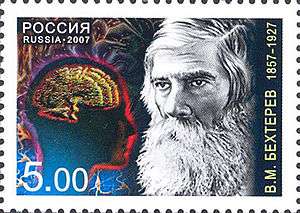
Russian Literature representatives like Leo Tolstoy, Fyodor Dostoevsky, Ivan Turgenev, Anton Chekhov, Alexander Pushkin, and many more, reached a high status in world literature. Prominent Russian novelists such as Tolstoy in particular, were important figures and have remained internationally renowned. Some scholars have described one or the other as the greatest novelist ever.[80]
Russian composers who reached a high status in the world of music include Igor Stravinsky, Pyotr Ilyich Tchaikovsky, Dmitri Shostakovich, Nikolai Rimsky-Korsakov, Sergei Prokofiev, Modest Mussorgsky, and Sergei Rachmaninoff.
Russian people played a crucial role in the victory over Nazi Germany in World War II. According to the British historian Richard Overy, the Eastern Front included more combat than all the other European fronts combined—the Wehrmacht suffered 80% to 93% of all of its total World War II combat casualties on the Eastern Front. Russia's casualties in this war were the highest of all nations, and numbered more than 20 million dead (Russians composed 80% of the 26.6 million people lost by the USSR), which is about half of all World War II casualties and the vast majority of Allied casualties.[81]
References
- "журнал "Демоскоп Weekly" № 571 - 572 14 - 31 октября 2013. А. Арефьев. Тема номера: сжимающееся русскоязычие. Демографические изменения - не на пользу русскому языку".
- Ethnic groups in Russia, 2010 census, Rosstat. Retrieved 15 February 2012 (in Russian)
- http://www.ukrstat.gov.ua/
- "Численность населения Республики Казахстан по отдельным этносам на начало 2016 года". stat.gov.kz.
- https://www.destatis.de/DE/Publikationen/Thematisch/Bevoelkerung/MigrationIntegration/AuslaendBevoelkerung2010200177004.pdf
- "Regarding Upcoming Conference on Status of Russian Language Abroad". Russian Ministry of Foreign Affairs. Archived from the original on 23 December 2015. Retrieved 24 June 2014.
- "American FactFinder - Results". Data Access and Dissemination Systems (DADS). Archived from the original on 12 February 2020. Retrieved 19 September 2016.
- http://jppi.org.il/uploads/Jewish_Demographic_Policies.pdf
- http://www.belstat.gov.by/upload-belstat/upload-belstat-pdf/perepis_2009/5.8-0.pdf
- "Archived copy". Archived from the original on 14 November 2018. Retrieved 18 January 2019.CS1 maint: archived copy as title (link)
- "Census Profile, 2016 Census". statcan.gc.ca.
- http://data1.csb.gov.lv/pxweb/en/iedz/iedz__iedzrakst/IRG070.px/table/tableViewLayout1/?rxid=d8284c56-0641-451c-8b70-b6297b58f464
- "Moldovan Population Census from 2014". Moldovan National Bureau of Statistics.
- "Archived copy". Archived from the original on 27 December 2018. Retrieved 18 January 2019.CS1 maint: archived copy as title (link)
- Maria Stella Ferreira Levy. O papel da migração internacional na evolução da população brasileira (1872 to 1972). inRevista de Saúde Pública, volume supl, June 1974.
- "Archived copy". Archived from the original on 11 June 2019. Retrieved 1 February 2020.CS1 maint: archived copy as title (link)
- https://www.ellitoral.com/index.php/diarios/2018/02/25/informaciongeneral/INFO-02.html
- "Archived copy". Archived from the original on 19 January 2019. Retrieved 19 January 2019.CS1 maint: archived copy as title (link)
- "Gyventojų pagal tautybę dalis, palyginti su bendru nuolatinių gyventojų skaičiumi". osp.stat.gov.lt. Retrieved 13 August 2017.
- "2006 census".
- "The State Statistical Committee of the Republic of Azerbaijan". azstat.org. Archived from the original on 7 January 2012.
- "communauté russe en France" (PDF).
- http://pxnet2.stat.fi/PXWeb/pxweb/fi/StatFin/StatFin__vrm__vaerak/statfin_vaerak_pxt_11rv.px/table/tableViewLayout1/?rxid=726cd24d-d0f1-416a-8eec-7ce9b82fd5a4
- "Australian Bureau of Statistics". Abs.gov.au. Retrieved 22 July 2012.
- "МИД России | 12/02/2009 | Интервью Посла России в Турции В.Е.Ивановского, опубликованное в журнале "Консул" № 4 /19/, декабрь 2009 года". Mid.ru. Archived from the original on 2 January 2016. Retrieved 22 July 2012.
- Informatii utile | Agentia Nationala pentru Intreprinderi Mici si Mijlocii (2002 census) (in Romanian)
- "(number of foreigners in the Czech Republic)" (PDF) (in Czech). 31 December 2016. Retrieved 6 October 2017.
- http://www.demoscope.ru/weekly/2013/0559/barom02.php
- "출입국·외국인정책 통계월보". 출입국·외국인정책 본부 이민정보과.
- The source is not Russian but Russian Koreans.
- http://census.ge/files/results/english/17_Total%20population%20by%20regions%20and%20ethnicity.xls
- Vukovich, Gabriella (2018). Mikrocenzus 2016 - 12. Nemzetiségi adatok [2016 microcensus - 12. Ethnic data] (PDF). Hungarian Central Statistical Office (in Hungarian). Budapest. ISBN 978-963-235-542-9. Retrieved 9 January 2019.
- "Utrikes födda efter födelseland, kön och år". www.scb.se. Statistiska Centralbyrån. Retrieved 25 May 2017.
- "(2000 census)". Stats.gov.cn. Retrieved 22 July 2012.
- "(2002 census)". Nsi.bg. Retrieved 22 July 2012.
- "(2002 census)" (PDF). Retrieved 22 July 2012.
- "rcnk.gr". April 2020.
- "Statistics Denmark 2019 K4: Russian". Statistics Denmark.
- "Census ethnic group profiles: Russian". Stats NZ. 2013.
- {{citeweb|url=http://www.cystat.gov.cy/ www.cystat.gov.cy| year=2004 |title=POPULATION CENSUS 2001 VOL4
- "Two sources of the Russian patrilineal heritage in their Eurasian context". American Journal of Human Genetics. 82 (1): 236–50. January 2008. doi:10.1016/j.ajhg.2007.09.019. PMC 2253976. PMID 18179905.
- some territories of the former Tsardom of Russia and Russian Empire; those territories where people self-identified as ethnic (Great) Russians lived many hundreds of years in the end of 19 century/the beginning of 20 century; population and state borders are changed many times peacefully of not peacefully because of many reasons in 20-21 centuries, but demographic processes are slow and not related to recent changes of state borders
- most (except for Caucasus, Tatarstan, etc.) of European territory of the Russian Federation, which became independent state in 1991, is native territory of ethnic Russians; Crimean Peninsula is not internationally recognized as a part of the Russian Federation; citizenship issues, state borders and ethnic processes are not related
- roughly translated as "multinational people of Russia" but the Russian word национальность (natsionalnost') means ethnicity, not "nationality" or "nation"
- Pravoslavie.ru. Retrieved 10 February 2016.
- Blöndal, Sigfús (16 April 2007). The Varangians of Byzantium. Cambridge University Press. p. 1. ISBN 9780521035521. Retrieved 2 February 2014.
- The Russian Primary Chronicle: Laurentian Text, Translated by O. P. Sherbowitz-Wetzor ISBN 0-910956-34-0
- "Online Etymology Dictionary". etymonline.com.
- "Топонимические следы руссов-славян в Рослагене : Доисторическая история славян : Александр Козинский". kozinsky.ru. Archived from the original on 14 August 2019. Retrieved 14 August 2019.
- "Руслаген". поисковая система. Archived from the original on 14 August 2019. Retrieved 14 August 2019.
- Максимович К.А. (2006). "Происхождение этнонима Русь в свете исторической лингвистики и древнейших письменных источников". КАNIEKION. Юбилейный сборник в честь 60-летия профессора Игоря Сергеевича Чичурова. М.: ПЕТГУ: сс.14–56.
- Седов В.В. Древнерусская народность. Русы
- "Новости NEWSru.com :: Учёные завершили масштабное исследование генофонда русского народа (Фотороботы)". Newsru.com. Retrieved 22 July 2012.
- Aleksey Uvarov, "Étude sur les peuples primitifs de la Russie. Les mériens" (1875)
- Мурома, мещера [Murom, Meschera]. emc.komi.com (in Russian). Archived from the original on 23 May 2008.
- "Russia - History". Encyclopedia Britannica. Retrieved 28 August 2018.
- Kunstmann, Heinrich. (1996). Die Slaven : ihr Name, ihre Wanderung nach Europa und die Anfänge der russischen Geschichte in historisch-onomastischer Sicht. Steiner. p. 214. ISBN 3515068163. OCLC 231684405.
- The Primary Chronicle is a history of the Ancient Rus' from around 850 to 1110, originally compiled in Kiev about 1113.
- Pivtorak. Formation and dialectal differenciaton of the Old Rus language. 1988
- "журнал "Демоскоп Weekly" № 571 - 572 14 - 31 октября 2013. А. Арефьев. Тема номера: сжимающееся русскоязычие. Демографические изменения - не на пользу русскому языку".
- Russians left behind in Central Asia. BBC News. November 23, 2005.
- "Saving the souls of Russia's exiled Lipovans". The Daily Telegraph. April 9, 2013.
- Bigg, Claire (15 August 2006). "Latvia: Ethnic Russians Divided On Moscow's Repatriation Scheme". Rferl.org. Retrieved 22 July 2012.
- "The Ghosts of Russia That Haunt Shanghai". The New York Times. 21 September 1999.
- excerpted from Glenn E. Curtis (ed.) (1998). "Russia: A Country Study: Kievan Rus' and Mongol Periods". Washington, DC: Federal Research Division of the Library of Congress. Archived from the original on 27 September 2007. Retrieved 20 July 2007.CS1 maint: extra text: authors list (link)
- http://www.ksk.edu.ee/wp-content/uploads/2011/03/KVUOA_Toimetised_12-Laats.pdf
- "Russia". Encyclopædia Britannica. Retrieved 31 January 2008.
- Microsoft Encarta Online Encyclopedia 2007. Russian Literature. Archived from the original on 20 August 2009. Retrieved 7 January 2008.
- "Russia::Music". Encyclopædia Britannica. Retrieved 5 October 2009.
- "A Tale of Two Operas". Petersburg City. Retrieved 11 January 2008.
- Garafola, L (1989). Diaghilev's Ballets Russes. Oxford University Press. p. 576. ISBN 0-19-505701-5.
- "Russia::Motion pictures". Encyclopædia Britannica. 2007. Retrieved 27 December 2007.
- "Арена".
- Olga Filina (Ogonek Magazine). Mapping Russia's Religious Landscape. Russia and India Report. Retrieved 24-09-2012.
- Верю — не верю. "Ogonek", № 34 (5243), 27/08/2012. Retrieved 24-09-2012.
- "Archived copy" Опубликована подробная сравнительная статистика религиозности в России и Польше (in Russian). Archived from the original on 2 December 2015. Retrieved 6 January 2016.CS1 maint: archived copy as title (link)
- "Русская линия / Библиотека периодической печати / Как пишутся страшные сказки о Церкви". Rusk.ru. 31 August 2005. Retrieved 14 May 2011.
- "statistics". Adherents.com. Archived from the original on 10 August 2018. Retrieved 22 July 2012.
- Victor Shnirelman. "Christians! Go home": A Revival of Neo-Paganism between the Baltic Sea and Transcaucasia Archived 3 March 2016 at the Wayback Machine. Journal of Contemporary Religion, Vol. 17, No. 2, 2002.
- "Russian literature." Encyclopædia Britannica. 2007. Encyclopædia Britannica Online. 16 July 2007 <>.
- Leaders mourn Soviet wartime dead, BBC News
External links

- Prominent Russians: faces of Russia – Russia Today
- (in Russian) 4.1. Population by nationality
- (in Russian) "People and Cultures: Russians" book published by Russian Academy of Sciences
- Pre-Revolutionary photos of women in Russian folk dress
